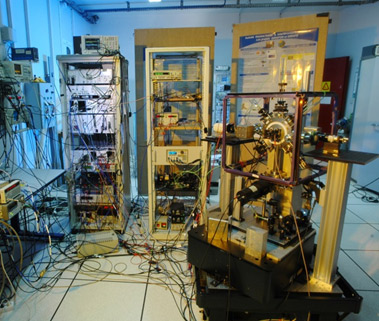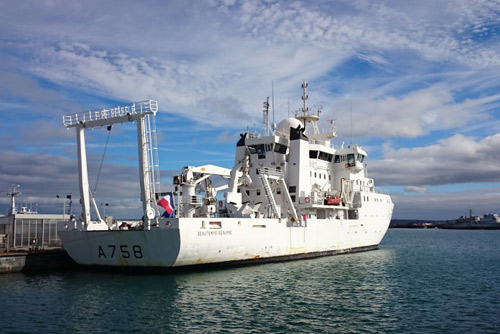World first. ONERA and the SHOM* have accomplished two gravity mapping campaigns off the coast of Brest. The atomic gravimeter designed and built at ONERA for marine use, provides an absolute measurement of the local gravity "g" with remarkable precision.
GIRAFE (and later GIRAFE2) - Shipborne cold atom research interferometric gravimeter - is a project that has been supported by the DGA (the French defense procurement agency) for nine years. It is also the name of the instrument: a gravimeter prototype, providing very accurate values, compatible with the sea conditions. This ONERA initiative is very much within ONERA’s area of expertise in navigation and inertial sensors (including space accelerometry). Prospects are numerous, especially in the areas of defense, aeronautics and space.
From a laboratory "quantum" instrument...
Cold atom gravimetry is based on atomic interferometry, which uses the quantum properties of matter. A cloud of cold rubidium atoms** is obtained by laser cooling and immobilization in a vacuum and then released, subject to its own weight. The atoms are divided into two packets with different quantum states and separate as they fall. The two packets of atoms, which behave as matter waves, are then recombined and result in an interference pattern analogous to that of an optical interferogram. Processing of the atomic interferogram enables the gravitational field value to be obtained.

GIRAFE2’s precursor: very accurate but not able to be shipborne
ONERA developed a first device in 2012 - GIRAFE, able to achieve an accuracy of 10-8 to 10-9g in the laboratory. In order to meet the project’s maritime needs in its second phase, a new device was designed and built, this time able to be shipborne, that is to say, capable of providing results with the best accuracy possible at sea, where measurement is hindered by waves and vibrations. ONERA’s research engineers thus overcame this challenge by developing the GIRAFE2 instrument. Given its laboratory accuracy potential, it needed to be tested at sea with the SHOM’s engineers.
Testing of the gravimeter on its gyrostabilized platform during a swell
... to an operational instrument, on calm to very rough seas

HBO Beautemps-Beaupré (80 m), a ship dedicated to the SHOM’s scientific campaigns (Research Vessel)
It was thus that in October 2015, GIRAFE2 was installed for five days on board the hydro-oceanographic ship Beautemps-Beaupré. The instrument was placed at the center of flotation of the ship (the place that moves the least) and mounted on a gyrostabilized platform. The gravity field was able to be surveyed with a spatial resolution of 500 m, confirming the known values, through the implementation of filters designed to remove parasitic effects due to the swell and the vibrations of the ship. The second campaign in January 2016 confirmed the accuracy of the measurements, even in a 5-6 m swell.

The GIRAFE2 sensor on its gyroscopic platform, near the center of the Beautemps-Beaupré,
where the vertical movement is minimum
Other gravimeters are relative instruments - they use masses suspended on springs, whose elongation is measured. They are less accurate, less robust and require frequent recalibration, therefore, for a ship, they require closely spaced stops and achieve a rather low productivity.
The future of GIRAFE2
GIRAFE2 is a demonstrator and can therefore only be used by specialists.
The next step could be to produce a version of the instrument in several specimens that can equip several ships and operate without intervention. Their performance would be improved and their electronic and optical components would be miniaturized.
Among the applications of this technology are the following: geophysics of ocean areas, exploration of the seabed (minerals, oil), gravity mapping and navigation without GPS. Airborne or space applications can also be envisaged.
ONERA fully involved in its role
ONERA research engineers have explored a technology based on atom cooling with lasers, a technique that led Claude Cohen-Tannoudji, Steven Chu and William D. Phillips to win the Physics Nobel Prize in 1997. They proposed to the DGA the bold project of creating such a gravimeter, based on cold atom matter wave interferometry and able to be shipborne. For the industrialists in this market and for the DGA, ONERA increased the TRL*** of this technology, thus greatly reducing the industrial risk of future developments.
Notes
* SHOM: Service Hydrographique et Océanographique de la Marine (Naval Hydrographic and Oceanographic Service)
** Rubidium: alkali metal whose atoms can be easily manipulated by "telecommunication" fiber lasers
***TRL: Technology Readiness Level, a measuring system used to assess the level of maturity of a technology (on a scale from 1 to 9)




